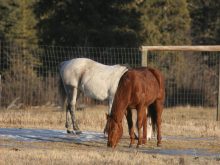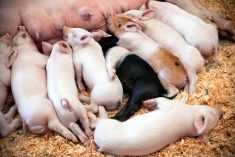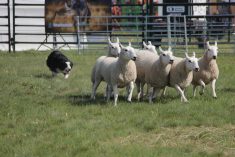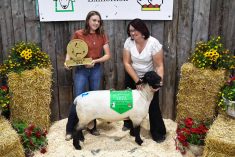A Manitoba rancher recently told his colleagues that they should think twice before turning up their noses at the thought of allowing sheep on their property.
Scoff if you like, Brian Greaves told the Manitoba Grazing School in early December, but keep in mind that a weaned calf would have to be worth $900 to $1,000 to be able to compete with the returns from sheep on a per-stocking-unit basis.
“You all know the benefits of rotational grazing,” he told cattle producers at the school.
“But add in another species and the benefits are further advanced.”
Read Also

Why selenium is still an important factor in horse health
Selenium is an essential equine trace mineral that supports antioxidant defense, muscle integrity, immune function, metabolism and thyroid activity.
He said sheep prices rise and fall depending on a number of factors, as do cattle prices. As well, during the BSE crisis sheep producers were hit just as hard as their cattle ranching counterparts.
However, Greaves said running sheep in the same pastures as his cattle offers benefits that extend beyond simple risk diversification, such as stronger pasture health, increased per-acre stocking density and more paycheques that come in at different times of the year.
“The sheep and the cattle don’t compete for the same pastures. The sheep will eat a lot of the pasture weed species that the cattle won’t touch,” he said.
“As long as you are rotationally grazing now, if you add one breeding ewe for every cow you have on your property, you will actually increase your cattle production.”
By pairing sheep and cattle, he said, his operation benefits from three income streams: beef, lamb and wool.
“The bank is a lot happier. I’ve got three incomes.”
During his presentation, Greaves showed slides of the improved condition of pastures on his 1,400-acre farm near Miniota.
The improvement process began in 1993 when his wife, Karen, and two children moved there. Some parts of the farm were weed-infested, overgrazed, run down and burned out, he said.
He subdivided the land into paddocks, seeded alfalfa and grasses and brought in 100 sheep.
“The benefits of rotational grazing are further enhanced by multi-species grazing,” he said.
“You get more animals per acre, maximize your pasture regrowth, maximize your weed control and extend the lifespan of your pastures.”
Production costs are lower because the alfalfa that he seeded into his pastures lasts longer under the multi-species system, and improved parasite control means less spending on medication.
“By alternating when they graze in the pastures, you’re breaking down the life cycle of internal parasites,” he said. “And you allow your animals’ feed needs to be better matched to your pasture growth.”
Two species adds flexibility. The herds can be grazed together or separately, depending on their nutritional needs at the time.
If a pasture is heavy on alfalfa and putting cattle in might lead to losses from bloat, sending the sheep in first to clear out most of the alfalfa helps reduce that risk.
Greaves said he has had good success by adding a few acres of grazing turnips in recent years.
“I plant turnips as soon as I can get on the land in April. I take the tops off in August, pull the animals off, then they go back on them in late September when we graze them right down to the bulbs.”
Winter feeding combines hay and haylage, with no grain except for a bit of oats for wintering calves.
To reduce costs, he has partnered with neighbours to buy equipment such as a seed drill, which he said is too expensive for individuals to own.
A neighbour combines Greaves’ oat and barley crops and in return Greaves drives the grain truck during the neighbour’s harvest.
Greaves also enlists the help of dogs, saying a well-trained Border Collie can do the work of three or four men when handling animals.
“Great Pyrenees not only guard the sheep during lambing, they also guard the cows. I’ve lost only one lamb in the past five years and no calves to coyotes.”
The guard dogs tend to keep the cattle and the sheep separate when grazing, he added.
“A lot of times you’ll see them grazing together with no problem whatsoever,” he said.
“But as soon as you hear a coyote howl, and one bark from the dogs, and the sheep are all mobbed up. The cows are all standing around wondering, ‘what’s going on here?’ “
Three electrified wires are enough to keep the sheep in, he said. If a predator chases them through the wires, they’ll often try to get back in on their own.
“But if any animal does start creep feeding themselves, well, they’re on the trailer and gone.”














